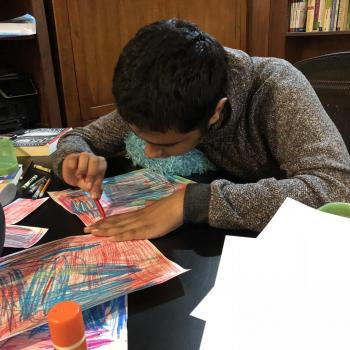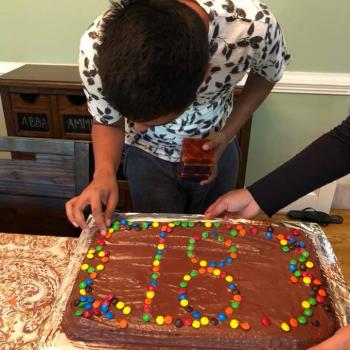
April 14, 2015 – Autism Awareness Month, Ali Family Autism Truths #14
Perseveration, according to Merriam-Webster.com, is a “continuation of something (as repetition of a word) usually to an exceptional degree or beyond a desired point.” According to good old Wikipedia, “in psychology and psychiatry, perseveration is the repetition of a particular response, such as a word, phrase, or gesture, despite the absence or cessation of a stimulus, usually caused by brain injury or other organic disorder.” Surprisingly, neither Merriam-Webster nor Oxforddictionaries.com have a meaning for the word “stim.”
But I do.
It’s what D does with beads. For the past nearly ten years.
Stim, the slang of perseverative behavior and short for “self-stimulatory behavior,” is something far too many autism familiars are familiar with. Many individuals with autism have some type of stimming behavior or something they stim on. The classic behaviors most textbooks associate with stimming include hand flapping, lining things up, toe-walking and a few others. D’s longest running stim to date is his fascination with spinning beaded necklaces. It’s been ten years and counting, and started with him spinning the attached pens on Magna Doodle toys to spinning into complicated knots the cords of our blinds. He would sit for hours on our kitchen table and spin the cords of the window blinds, until I started buying mardi gras beads from party stores and giving those to him.
He loved them.
We went through hundreds of those beads, which I hated because they broke easily, and D often mouthed them. I worried about the paint on the beads, and once I discovered a bead off of one of those necklaces in baby H’s diaper. He had found it on the floor, ingested it, and it emerged out the other end. That’s when my mom started giving us metal beaded lanyards, the kind which office workers wear their badges on. They were a God-send, and we began ordering them online by the hundreds. D loses them every day, and I wonder where all these beads end up. But we keep an endless supply at home, in my purse, in our cars and wound around my wrist.
D could spin beads all day long on an endless loop if I let him. He craves his beads. And, we have a love-hate relationship with this stim. For years, I was of the opinion that bead spinning needed to be reserved for certain times. Because when he spins his beads, he gets so stimulated by it and so into it that it can be even more so difficult to reach him. And, I wanted him to learn to engage more with the world, with people, with the things teachers were trying to teach him. So for years I dictated that he shouldn’t be allowed beads when riding the bus or in school at all. I’d tell teachers to hide any type of beads in his classroom.
But as time has passed and as we’ve gone through some horrendous crises with D, I’ve come to the conclusion that maybe this bead stim is something we can work with. If it makes him happy, if it brings him some sort of ease, then maybe the stim is something that deserves more respect. Those with autism and their loved ones disagree a lot about if ongoing perseverative behaviors are harmful or helpful. Some work hard to decrease stims, believing that the reduction or elimination of such behaviors will be beneficial. Others feel that working with the stim, understanding the nature of these behaviors and what they mean to those who do them is a better way.
Frankly, I don’t know what is the better way. I only know spinning beads is as big a part of D’s personality and his life as is his love of biryani and his love for his family.
When we were living in New York in a one-bedroom apartment with newly-diagnosed, three-year-old D and newly-born daughter A, there was a group of adults with special needs who lived in two two-bedroom apartments at the end of our hallway with their caregivers. As I struggled and wept and lost myself in that first frantic year of knowing D officially was diagnosed with autism, I watched this group of adults live their lives in front of me. One man, he must have been in his 40s or 50s, always wore a baseball cap and fingered a small ball in his hand. He was constantly tossing and catching that ball or passing it back and forth between the fingers of his right hand. It never left his hand. He stimmed on that ball constantly. I never heard him speak.
I watched him and felt overwhelming, competing surges of affection and despair, wondering if that was my son’s future. At the time, D wasn’t into spinning beads. But I wondered.
And, here we are now. And the truth of it is that I still have overwhelming, competing surges of affection and despair, watching D spin his beads. And yet, everywhere I go, especially when he is not with me, I am compelled to carry beads in my pocket or wear them on my wrist.
They are my touchstones. He is my touchstone.











